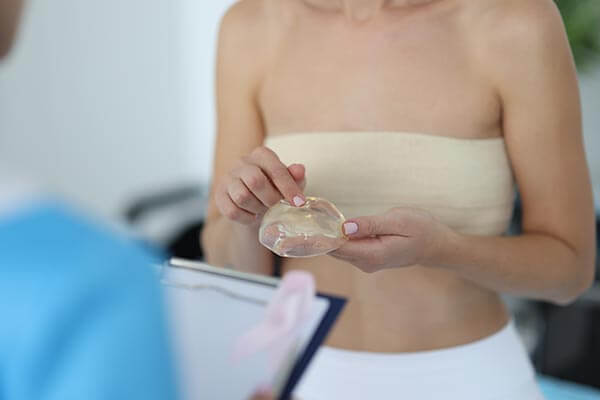Breast Augmentation/Breast Implants
Breast Augmentation Melbourne
Breast Augmentation Surgery involves placing a breast implant under the breast tissue or muscle of the chest wall.
A breast augmentation procedure, also known by some as breast enlargement surgery, breast implants or even a “boob job” is a form of cosmetic surgery which aims to increase breast size, improve shape and/or restore symmetry to the breasts. It is sometimes combined with a breast lift Melbourne (mastopexy) procedure.
A statement on breast implant safety by the Australian Society of Plastic Surgeons
(written 26th November 2018)

Common reasons why women consider having breast augmentation surgery
There are many reasons women may consider breast augmentation surgery. These include:
- Appearance – Wanting bigger or improved breast projection/desire for cleavage.
- Bring overall body shape into proportion.
- After children or having lost a significant amount of weight the breasts may be particularly droopy or “empty”.
- Breast asymmetry – Breasts of different size/shape. This may be congenital/developmental or result from trauma or cancer management.
- Post-surgery as part of breast reconstruction.
What is involved with breast augmentation surgery?
- General anaesthetic.
- Surgery Duration: Approximately 1-2 hours.
- Incision most commonly just under breast approximately 6cm in length.
- A space is developed either below the muscle or just above it to place the implant into.
- A sizer may be utilised in theatre as a final check to determine the most appropriate implant size and shape for you.
- Drain tubes – These may be used and if so are generally removed the next morning.
Recovery After Surgery
This surgery is generally completed with an overnight stay in hospital. In certain circumstances it may be possible to do the surgical procedure as a day case.
- Most patients may generally feel a little uncomfortable for a few days – more so if the implant is placed under the muscle.
- A gradual increase in mobility and activity; patients are generally back to most normal day to day activities at two weeks.
- Most women allow approximately two weeks off work. However, you may require additional time if your job is more physically demanding. This can be discussed with A/Prof White.
- Able to drive when feeling comfortable to do so.
- No heavy lifting/exercise for 6 weeks e.g. avoid gym, aerobics, running.
- A supportive bra without an underwire is recommended for the post-operative period. (Note: Do not wear a crop type bra as these tend to flatten the breasts.)
- A suitable bra will be provided by A/Prof White’s rooms and fitted at the time of surgery. This is to be worn for 6 weeks after the surgery.
Post-Operative Care and Review Appointments
Post-operative visits with A/Prof White:
Approximately one week after surgery
– Aim: To ensure you are healthy and to review wound healing of the surgical wounds.
Six weeks post-surgery
– At this time you will have a better idea of what the final result from surgery will be like. If all is progressing well, A/Prof White will give you the all-clear to resume normal activities.
12 months
– If there are any concerns you will be seen more frequently.
Surgical Goals
Much the same as any other plastic surgery procedure or cosmetic procedure, breast augmentation surgery has a range of goals, which include:
- YOUR SAFETY.
- Address the individual issues you will have discussed with A/Prof White related to your decision to have this particular surgery.
- Achieve good projection/“perkiness”.
- Achieve good cleavage area.
- Minimise scars.
- Durable, long term pleasing shape.
Considerations before breast augmentation surgery
Before deciding to have breast enhancement/augmentation surgery you should consider the following:
- Desire for any further children.
- Stable, healthy weight.
- If you are a smoker: STOP Smoking.
- Generally otherwise fit and healthy.
- Breast screening up to date: In women over 50 and/or where regular breast screening and mammograms has been recommended.
- Patients need to be at least over 18 years old and have finished breast development.
These considerations will be discussed at your initial consultation.
Implant Types and Materials
The implant shell or outer layer of all breast implants is made of silicone. The fill or inner substance is either a silicone gel or saline (salt water).
Silicone Fill
Older implants had a very low viscosity of silicone (very runny). This meant that when an implant leaked the silicone spilled through the breast tissue and was very difficult to remove. It could lead to lumps (granulomas) in the breast and surrounding soft tissues.
Current implants are made from “cohesive gels” which means that dispersion of a ruptured implant is not generally a problem (they are like turkish delight in consistency).
Silicone products have not been shown to cause connective tissue diseases. There was some concern about silicone implants in the 1990’s but long term studies have not shown any link. A/Prof White generally uses silicone filled implants as he feels that they have a more natural feel.

Saline filled implants
If saline implants break, they will deflate almost instantaneously. They generally have more palpable and even visible rippling of the shell.
Implant Shape
Round
Anatomical or Tear drop shaped
Implant Surface
Smooth
Textured
PLEASE NOTE:
It is currently thought that textured implants increase the rate of ALCL (Anaplastic Large Cell Lymphoma). This is a very rare complication associated with breast implants. Macro-textured implants (Very rough surface) have been withdrawn from the market. Microtextured (Lesser degree of roughness) have a relatively lower rate (Approximately 1 in 50000).
Implant Position
Subglandular
Submuscular
Surgical Approach
Inframammary
Implants can be put in through an incision beneath the breast (with the scar ending up in the new breast crease).
Axillary
Through an incision in the armpit.
Peri-areolar
Around the areola (coloured area around the nipple).
Trans umbilical
Through the umbilicus (belly button).

Desired goals/appearance
To help you and A/Prof White determine what look you are after, it may be helpful to think about it in terms of four groups.
- Grade 1 – No one can really tell you’ve had an implant. May be useful to refill the soft tissue after breast feeding, pregnancy or weight loss.
- Grade 2 – Your friends may notice that there has been a change.
- Grade 3 – Starting to look more obvious. There is more prominent cleavage. Some people will probably know or suspect that you have had breast implant surgery.
- Grade 4 – Look very artificial – not natural. A/Prof White generally does not perform very large implants or try to achieve Grade 4 look. The complications both in the short and long-term increase with the larger size implants.
Alternatives to surgery
- No surgery or delaying surgery.
- Using a professionally fitted bra with additional padding and/or inserts to enhance or improve your natural shape and appearance of your breasts.
- Fat injections or non-permanent fillers.
Risks To Consider
All surgical or invasive procedures carry risks. Breast augmentations are no different, though A/Prof Dean White will aim to deliver you the best results in a safe manner, and only perform breast augmentation procedures on suitable candidates to reduce the risk of breast augmentation complications.
Anaesthetic
In otherwise well people, general anaesthesia is very safe with modern techniques. A/Prof White’s rooms will give you the details of your anaesthetist prior to surgery to discuss any specific concerns.
Bleeding/Haematoma
This may need a return to the operating theatre to evacuate a blood clot.
Infection in the wound
If this does occur, it can usually be cleared up with antibiotic tablets.
Infection affecting the implant
Despite sterile surgical techniques and covering antibiotics in a small proportion the implants can become infected. Sometimes this can be treated with antibiotics but it may be necessary to take the implants out and replace them at a later time to completely resolve the infection.
DVT/PE (Deep venous thrombosis/pulmonary embolus)
Blood clots that are potentially very serious and even life threatening which can form in the legs and travel to the lungs. Multiple strategies are employed to minimise the risk of these occurring.
Scars
Typically the resulting scars are at their thickest and reddest at 6-10 weeks after surgery. Scars continue to mature and improve for up to 18 months after surgery. Scar management advice will be discussed in your follow up visit with A/Prof White to assist in achieving the goal of a thin, barely noticeable scar.(Note: The resulting scar is usually about 6cm in or near the fold under the breast.)As the skin is being stretched by the implant new stretch marks may appear or old ones may become more noticeable. Sometimes veins may also become more prominent.
Wound separation/delayed healing
This is much more common in smokers or if there is an infection.
Sensation
This is rarely altered with surgery. The nipple area may be numb or may even become more sensitive. This may affect both normal sensation and erotic sensation. Generally this settles down over weeks to months.
Symmetry
The final result will take several months to achieve. The majority of women have different sized or shaped breasts before surgery. These differences are taken into account for your operation but small differences may continue to exist or even new ones created. Small differences may be increased after augmentation. Scars may also be slightly different on your right compared to left side.
Implant Rotation
Round implants can flip and anatomical implants can flip or rotate. Both are uncommon.
Breast Feeding
Ability to breastfeed after this surgery is generally unaffected. The changes associated with pregnancy and/or breast feeding can result in significant changes to the breast shape and implant position. This may necessitate revisional surgery.
Breast Cancer
The risk of breast cancer is no higher or lower with this type of surgery. It is prudent to address any concerns in this area prior to breast surgery. Mammograms may need special views – it is important to inform radiology staff about your breast implants.
Lymphoma (ALCL - Anaplastic Large Cell Lymphoma).
There have been recent reports about the presence of lymphoma in patients with delayed (up to 10 years after surgery) seroma (fluid build-up). This may necessitate further surgery, chemotherapy and/or radiotherapy. Please note that it is currently thought that textured implants increase the rate of ALCL (Anaplastic Large Cell Lymphoma). This is a very rare complication associated with breast implants. Macro-textured implants (Very rough surface) have been withdrawn from the market. Microtextured (Lesser degree of roughness) have a relatively lower rate (Approximately 1 in 50000).
Frequently Asked Questions
Is breast augmentation painful?
Anaesthesia is used during the procedure. After the surgery, you will have some tenderness and discomfort. This is usually adequately improved by over-the-counter pain relief and should improve within a few weeks.
How long do breast implants last?
Most implants generally last for more than a decade, and in some cases, this may extend to two.
What is the difference between breast augmentation and a breast lift?
Breast augmentation involves the insertion of implants to change the shape and volume of the breast. A breast lift is a surgical procedure involving removal of skin and fat, the elevation of the breast and nipple, and the reduction of the areola size if required.
Do I need to lose weight before a breast augmentation?
It is best to be at a healthy weight prior to this procedure. If you lose or gain weight after getting implants inserted, your breast size may no longer be proportionate with your body.
Can I breast feed after breast augmentation?
Most people can still breastfeed with breast implants.
Will I lose feeling in my nipples after breast augmentation?
Numbness can occur for a few weeks after the procedure. However, this is temporary for most people.
Breast Implant Illness

Capsular Contracture
Rippling
Changes over time
Muscle implant movement
Breast shape can change over time
Breast implant register
No Surgery Is Risk Free.
Breast augmentations in Melbourne
Associate Professor Dean White is a specialist plastic surgeon located in Melbourne who is an expert in breast augmentations among other plastic surgical treatments. Contact him today to book in for a consultation and see what breast implants you may be suitable for.
Breast Surgery Resources

Breast Reductions for Athletes
Reducing the size of your breasts Key Takeaways: Breast size is a personal preference; larger is not always considered better Many athletes and active

How long will breast implants last?
Modern implants are designed to last for ten years or more. Breast implants can effectively increase the size of the breasts, and can also

